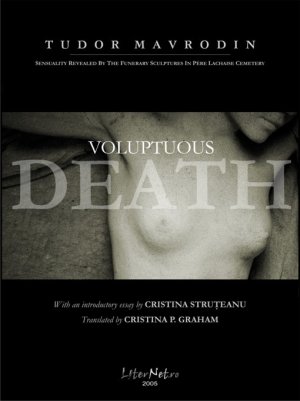Art and Nothingness
Maria Constantinescu-Condruț
Voluptuous Death - Sensuality revealed by the funerary sculpture in Père Lachaise Cemetery. What an interesting and provocative subject for a photographer! To find in this realm of death not the pain, not the sorrow, not the painful unrest following the disappearance of a human being, but the sensuality and the cozy feeling of remembering, shaped as a statue like an ensuing message of the living to the other world. The tombstones, sometimes rotten by the years flowing to oblivion, speak to us in a specific language, the classic language of sculptural esthetics.There is no author, novelist or poet, painter or musician (a photographer in our case) who thought in his or her inspirational moment about how art critics would interpret later on his or her masterpiece. Only dogmatic art has a predefined aim. And obviously, the way in which a critic sees an art piece reflects his or her own experience in life, education, social relationships and so on. Regarding the funerary sculpture - a customized masterpiece nonetheless - there is something dogmatic in its nature too. The client wants to depict a certain feeling imposing his or her own taste, orders according to a budget who knows - and the combination of those factors shape the final work of art. With one remark: a great artist always tries to convey his or her own self.
The photographer's selective eye finds amongst the statues from Père Lachaise Cemetery those elements that compose and decompose the sensuality. The Death that inspires art, the art that gives life. There is no exaggeration in such statement. A picture of one funeral statue shows a laying mother breast feeding her newborn. The scene is real, warm and alive. Birth, life, death, birth... an endless chain of changes. This image brings to mind Omar Khayyam's poetry:
"What are people? Charms hanging from the sky
Are coming, are going and are coming again.
From the pouch of the earth and from the box of the heavens
Beings are wrought as God is undying. "
The sense of transience and anguish crumbles facing the almighty God. And what else are the artists of Père Lachaise, other than children of God.
Tudor Mavrodin's photography reveals nudity as an absolute expression of beauty and sensuality hidden by the clothes. Curved lines of the woman's body, the gracious head, the hair, daring shapes and sensual lips, a hand with a rose or a foot revealed by the drapes, the eyes, the look...dreaming or longing for the missing one, the deepest tenderness or an enigmatic smile. The photographer cuts out the detail from the whole; the pictures flow like a movie that can be stopped anytime in order to contemplate an expressive and arresting stop-frame. Angles of sight, staring at the sky or falling down to the ground, a face covered by drapes and an arm resting on a wall, a woman falling down over a tomb, praying hands, a neck adorned by pearls. But what is the meaning of the beheaded statue at the end of the photographic series? Could it be a decapitated symbol of death, a negation of nothingness?
The new E-book published at the LiterNet Publishing House is a provocative invitation to meditate about life and death and much more. It is evidence about redemption trough the beauty of art.
"Voluptuous Death" - the quoted title from the Romanian national poet, Mihai Eminescu - could be a philosophic concept (transposed in sculpture and photographically reproduced) reflecting perpetual cycle of human nature.
Take a look at these pictures and you will discover so much life in there that only art creates, conquering the nothingness.
